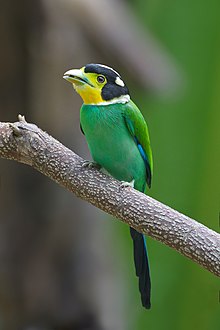Eurylaimidae
| Broadbills | |
|---|---|

| |
| Banded broadbill Eurylaimus javanicus | |
| Scientific classification | |
| Domain: | Eukaryota |
| Kingdom: | Animalia |
| Phylum: | Chordata |
| Class: | Aves |
| Order: | Passeriformes |
| Superfamily: | Eurylaimoidea |
| Family: | Eurylaimidae |
| Genera | |
|
Philepitta | |
The broadbills are a clade of small passerine birds, Eurylaimidae (named after the type genus Eurylaimus). The Smithornis and Pseudocalyptomena species occur in sub-Saharan Africa; the rest extend from the eastern Himalayas to Indonesia and the Philippines. The family possibly also includes the sapayoa from the Neotropics and the asities from Madagascar, although many taxonomists now separate each of the three into distinct families.
Description
Many of the broadbills are brightly coloured birds that present broad heads, large eyes and a hooked, flat and broad beak. They range from 13 to 28 centimetres in length, and live in the dense canopies of wet forests, allowing them to hide despite their brightly coloured plumage.[1] The plumage of the juveniles eurylaimids are similar to those of the adults, differing in being duller and shorter-winged and shorter-tailed in some cases.[2]
Behaviour and ecology
The broadbills are for the most part insectivorous and carnivorous. Prey taken include insects, spiders, centipedes, and millipedes, as well as lizards and tree frogs. Prey is obtained by sallying from a perch to snatch it in flight, and gleaning the prey off leaves and branches while flying. Some species may take some fruit, but only the green broadbills of the genus Calyptomena and the Grauer's broadbill are primarily frugivores (which also take some insects as well).
They are generally gregarious, with many species moving about in flocks of about 20 individuals. Broadbills attach their purse-shaped nests to suspended vines, and leave a tail of fibres hanging below it. This gives the nest the appearance of being random debris caught in the tree, an effect further enhanced by the birds covering the nest with lichen and spider webs.[1] Broadbills typically lay two to three eggs.
Taxonomy and systematics
The sapayoa was originally classified in the group Pipridae, according to at least one author,[3] the genus more accurately now suggests its own family, or placement here. The four species of asities, a family endemic to Madagascar, are sometimes included in the broadbills.[4] It has been suggested that the group is not monophyletic.[5]

Family Eurylaimidae
- Genus: Philepitta
- Velvet asity, Philepitta castanea
- Schlegel's asity, Philepitta schlegeli
- Genus: Neodrepanis
- Common sunbird-asity, Neodrepanis coruscans
- Yellow-bellied sunbird-asity, Neodrepanis hypoxantha
- Genus: Philepitta
- Subfamily: Smithornithinae - typical African broadbills
- Genus: Smithornis
- African broadbill, Smithornis capensis
- Grey-headed broadbill, Smithornis sharpei
- Rufous-sided broadbill, Smithornis rufolateralis
- Genus: Smithornis
- Subfamily: Pseudocalyptomeninae
- Genus: Pseudocalyptomena
- Grauer's broadbill, Pseudocalyptomena graueri
- Genus: Pseudocalyptomena
- Subfamily: Calyptomeninae - Asian green broadbills
- Genus: Calyptomena
- Green broadbill, Calyptomena viridis
- Hose's broadbill, Calyptomena hosii
- Whitehead's broadbill Calyptomena whiteheadi
- Genus: Calyptomena
- Subfamily: Eurylaiminae - typical Asian broadbills
- Genus Corydon
- Dusky broadbill, Corydon sumatranus
- Genus: Cymbirhynchus
- Black-and-red broadbill, Cymbirhynchus macrorhynchos
- Genus: Eurylaimus
- Banded broadbill, Eurylaimus javanicus
- Black-and-yellow broadbill, Eurylaimus ochromalus
- Genus: Sarcophanops
- Wattled broadbill, Sarcophanops steerii
- Visayan broadbill, Sarcophanops samarensis
- Genus: Psarisomus
- Long-tailed broadbill, Psarisomus dalhousiae
- Genus: Serilophus
- Silver-breasted broadbill, Serilophus lunatus
- Genus Corydon
References
- ^ a b McClure, H. Elliott (1991). Forshaw, Joseph (ed.). Encyclopaedia of Animals: Birds. London: Merehurst Press. pp. 158–158. ISBN 1-85391-186-0.
- ^ del Hoyo, J.; Elliott, A.; Christie, D. (2003). Handbook of the Birds of the World. Volume 8: Broadbills to Tapaculos. Lynx Edicions. ISBN 84-87334-50-4.
- ^ Sapayoa aenigma: a New World representative of 'Old World suboscines'[permanent dead link]
- ^ Prum, R. 0. (1993). "Phylogeny, biogeography, and evolution of the broadbills (Eurylaimidae) and asities (Philepittidae) based on morphology". Auk. 110: 304–324.
{{cite journal}}: CS1 maint: numeric names: authors list (link) - ^ Olson, SL (1971). "Taxonomic comments on the Eurylaimidae" (PDF). Ibis. 113: 507–516. doi:10.1111/j.1474-919x.1971.tb05185.x.
External links
- Broadbill videos on the Internet Bird Collection
